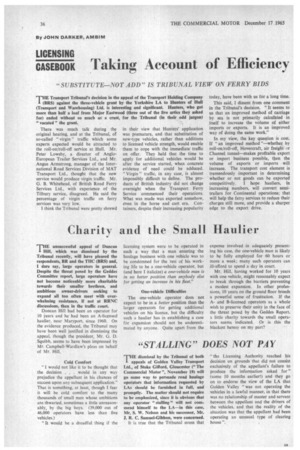LICENSING
Page 38

If you've noticed an error in this article please click here to report it so we can fix it.
CASEBOOK Taking Account of Efficiency
"SUBSTITUTE-NOT ADD" IS TRIBUNAL VIEW ON FERRY BIDS
TiE Transport Tribunal's decision in the appeal of the Transport Holding Company (1BRS) against the three-vehicle grant by the Yorkshire LA to Hunters of Hull (Transport and Warehousing) Ltd. is interesting and significant. Hunters, who got more than half a loaf from Major Eastwood (three out of the five artics they asked for) ended without so much as a crust, for the Tribunal (in their odd jargon) " vacated " the grant.
There was much talk during the original hearing, and at the Tribunal, of so-called " virgin " traffic which some experts expected would be attracted to the roll-on/roll-off service at Hull. Mr. Peter Lowsby, a director of AngloEuropean Trailer Services Ltd., and Mr. Angus Armstrong, manager of the International Road Services Division of MAT Transport Ltd., thought that the new service would produce virgin traffic. Mr. G. B. Whitehead, of British Road Ferry Services Ltd., with experience of the Tilbury service, disagreed. He said the percentage of virgin traffic on ferry services was very low.
I think the Tribunal were pretty shrewd in their view that Hunters' application was premature, and that substitution of new-type vehicles, rather than additions to licensed vehicle strength, would enable them to cope with the immediate traffic on offer. They held that the time to apply for additional vehicles would be after the service started, when concrete evidence of need could be adduced. "Virgin " traffic, in any case, is almost impossibly difficult to define. The products of British industry did not change overnight when the Transport Ferry Service commenced their operations. What was made was exported somehow, even in the horse and cart era. Containers, despite their increasing popularity today, have been with us for a long time.
This said, I dissent from one comment in the Tribunal's decision. "It seems to us that an improved method of carriage by sea is not primarily calculated in itself to increase the volume of either imports or exports. It is an improved way of doing the same work."
In my view, the key question is cost. If "an improved method "—whether, by roll-on/roll-off, Hovercraft, air freight Channel tunnel—makes profitable export or import business possible, then the volume of exports or imports will increase. The transport cost element is tremendously important in determining whether or not goods can be exported competitively. I hope hauliers, in increasing numbers, will convert semitrailers for Continental operations; that will help the ferry services to reduce their charges still more, and provide a sharper edge to the export drive.












































































































